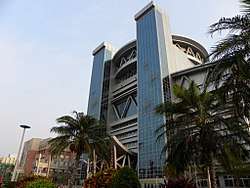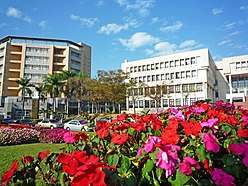Chiayi
Chiayi (Taigi POJ: Ka-gī; Chinese: 嘉義), officially known as Chiayi City, is a city located in the plains of southwestern Taiwan. Formerly called Kagee during the late Qing dynasty and Kagi during the Japanese era (Chinese and Japanese: 嘉義), its historical name is Tirosen.
Chiayi 嘉義市 Ka-gi, Kagi, Chiai, Chia-i | |
|---|---|
| Chiayi City | |
 Clockwise from top left:View of night in Chiayi, Chiayi Confucius Temple, Fountain at the Lantan Reservoir, Chiayi City Sports Arena, Chiayi Sun Shooting Tower, Chiayi National University | |
 Flag  Logo | |
| Nickname(s): Peach City (桃城) or Jia City (嘉市) | |
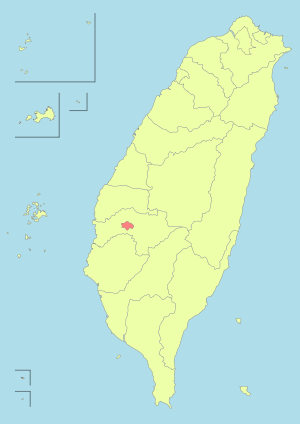 | |

| |
| Country | |
| Region | Southern Taiwan |
| Seat | East District |
| Districts | 2 districts
|
| Government | |
| • Type | Chiayi City Government |
| • Mayor | Huang Min-hui (KMT) |
| Area | |
| • Provincial city | 60.03 km2 (23.18 sq mi) |
| Area rank | 21 out of 22 |
| Elevation | 69 m (226 ft) |
| Population (2016)[2] | |
| • Provincial city | 270,254 |
| • Rank | 18 of 22 |
| • Density | 4,500/km2 (12,000/sq mi) |
| Time zone | UTC+8 (National Standard Time) |
| Postal code | 600 |
| Area code(s) | 05 |
| ISO 3166 code | TW-CYI |
| Flower | Hong Kong orchid tree (Bauhinia blakeana) |
| Tree | Hong Kong orchid tree |
| Website | www.chiayi.gov.tw |
| Chiayi City | |||||||||||||||||||||||||||||||||||||||
|---|---|---|---|---|---|---|---|---|---|---|---|---|---|---|---|---|---|---|---|---|---|---|---|---|---|---|---|---|---|---|---|---|---|---|---|---|---|---|---|
.svg.png) "Chiayi" in Traditional (top) and Simplified (bottom) Chinese characters | |||||||||||||||||||||||||||||||||||||||
| Chinese name | |||||||||||||||||||||||||||||||||||||||
| Traditional Chinese | 嘉義市 | ||||||||||||||||||||||||||||||||||||||
| Simplified Chinese | 嘉义市 | ||||||||||||||||||||||||||||||||||||||
| |||||||||||||||||||||||||||||||||||||||
| Japanese name | |||||||||||||||||||||||||||||||||||||||
| Kanji | 嘉義市 | ||||||||||||||||||||||||||||||||||||||
| Kana | かぎし | ||||||||||||||||||||||||||||||||||||||
| |||||||||||||||||||||||||||||||||||||||
History
Early history
First inhabited by the Hoanya aborigines, the region was named Tirosen (variants Tirocen, Tiracen). With the arrival of Han Chinese immigrants in southwestern Taiwan, the name evolved to become Tsulosan (Chinese: 諸羅山; pinyin: Zhūluóshān; Pe̍h-ōe-jī: Chu-lô-san) in Hokkien. Eventually, Tsulosan was shortened to simply Tsulo. Because of the choice of the characters, it has been mistakenly suggested that the origin of the name came from the expression "mountains surrounding the east". "Peach City" is another name for Chiayi City due to its peach-shaped territory in ancient times. The tip of the peach is around Central Fountain and was called "Peach-tip" by citizens.
Tsulosan was once the foothold to which people from the mainland immigrated. In 1621, Chinese Peter, who came from Zhangzhou, Fujian Province, first led his people to cultivate this land after they landed at Ponkan (modern-day Beigang).
Dutch Formosa
Records from the Dutch era show Tirosen as the usual form of the name; it also occurred as Tirassen, Tirozen, Tilocen, Tilossen, Tilocen, and Thilocen.[3] The place was north of Mattau (modern-day Madou, Tainan) and south of Favorlang (Huwei, Yunlin).
Kingdom of Tungning
In 1661 (the 15th year of Yung-Li, Ming dynasty), Koxinga defeated the Dutch based in Taiwan and founded the Kingdom of Tungning. He established one province, Cheng-Tien-Fu, and two counties, Tien-Hsing and Wan-Nien, demarcated by the Hsin-Kang River (Chinese: 新港溪, now the Yanshui River). Chiayi was under the jurisdiction of the Tien-Hsing County.
Qing dynasty
In 1683, when Qing rule began, the island was governed as Taiwan Prefecture under the administration of Fujian Province. In 1684, Tsulo County was established and initially encompassed the underdeveloped northern two-thirds of Taiwan. (Taiwan and Hongsoa counties were divided from Wan-Nien County during the Kingdom of Tungning, which was changed from Tien-Hsing County.) In 1704, the county seat was moved to Tsulosan, the site of modern-day Chiayi City, and had wooden city walls.
In 1727, the county magistrate, Liu Liang-Bi rebuilt the gatehouses and set a gun platform for each gatehouse. The four gatehouses were named: "Chin Shan" (襟山) for East, "Tai Hai" (帶海) for West, "Chung Yang" (崇陽) for South, and "Kung Chen" (拱辰) for North. In 1734 (the 12th year of Yongzheng), magistrate Lu-Hung built piercing-bamboo to better protect the city.
In 1786, the Lin Shuangwen rebellion was an attempt to siege Tsulosan but failed to overcome the defense of the inhabitants. Consequently, on November 3 of the next year, the Qing Emperor conferred the name Kagee (嘉義; lit.: 'commended righteousness') to praise the citizens' loyalty.
In the mid-1800s, a custom of annual riotous mass stoning developed in the city.[4]
In 1887, a separate Taiwan Province was declared and the island was administratively divided into four prefectures; the city of Kagee belonged to Tainan Prefecture.
Japanese rule

In 1895, Taiwan was ceded to Japan in the Treaty of Shimonoseki. The 1906 Meishan earthquake devastated the entire city wall except the Eastern Gate. The Japanese authorities reconstructed the city. Industries and trades started to flourish. According to the census taken in 1904, Kagi was the fourth most populous city in Taiwan, with a population of over twenty thousand.[5]
The Great Kagi earthquake (later also known as the 1906 Meishan earthquake) struck the city in mid March 1906.[6]
In looking over some of my more recent Notes, it seems impossible to make the foregoing references to Ka-gi without adding a few words about that dreadful earthquake which devastated the region in March 1906. I was there soon after, and had a profound feeling of sadness on seeing whole streets covered with fallen beams and other debris ; on seeing, too, so many traces of the awful suffering on every side. Within Ka-gi city, and a limited area around, 1,216 persons were suddenly thrust out into the eternal world. Not fewer than 2,306 persons were seriously injured, and 13,259 houses were laid low. The great mysterious Power then tore the earth into deep, open chasms in several places. Many of the narrow escapes and calamities were very affecting ; particularly that of our blind evangelist Toa-un, who ran out of doors with his wife as the shaking began. The demented mother, however, could not bear the thought of her two helpless young children being left behind, and she darted in to rescue them, when my poor blind pupil became childless and a widower in an instant of time. No sooner had the Governor-General at Tai-pak received telegraphic information of the magnitude of the calamity, than instructions were issued for a large company of surgeons, nurses, and assistants to proceed at once to Ka-gi. Wide hospital-sheds were erected without delay, and the work of relief was carried on with a rare amount of self-denial and promptitude. Even already, the city has lost much of its most desolate appearance, and the projected improvements give promise that it will have a more attractive look than ever. - William Campbell, 1915
In 1907, the construction of Alishan Forest Railway to Mount Ali was begun. In 1920, the city became an autonomous group as Kagi Town (嘉義街), Kagi District, within Tainan Prefecture, which included modern-day Tainan City, Chiayi County and Yunlin County. In 1930, the town was upgraded to an autonomous city under the same prefecture.
Post-war

In 1945, when Japan relinquished control of Taiwan on 25 October 1945, Chiayi City was established as a provincial city of Taiwan Province. On 16 August 1950, because of the re-allocation of administrative areas in which Taiwan was divided into 16 counties, five provincial cities and a special bureau, Chiayi City was downgraded to a county-controlled city and merged with Chiayi County to be the county seat. As a result, a shortage of capital hindered its development. On 1 July 1982, Chiayi City was elevated again to a provincial city as a result of pressure from local elites. On 6 October 1990, the East District and West District were established.[7]
Geography



Chiayi City is located on the north side of Chianan Plain, south west of Taiwan Island. On the east side is the Mount Ali, on the west side is the Chiayi Airport, on the north side is the Puzi River and on the south side is the Bazhang River. The distance from east to west of Chiayi City is 15.8 km (9.8 mi) and from north to south is 10.5 km (6.5 mi) with a total area of 60.0256 km2 (23.1760 sq mi). Chiayi City is completely surrounded by Chiayi County. Most of Chiayi City land are broad flat fertile plains. The terrain slowly rises from west to east.
Climate
Chiayi City has a warm humid subtropical climate (Köppen Cwa). Northeasterly winds during fall and winter mean that rainfall is depressed during that time, while southwesterly winds during summer and the later portion of spring bring most of the year's rainfall, with more than 60% falling from June to August. Humidity is high year-round, even during winter.
| Climate data for Chiayi (normals 1981–2010, extremes 1968–present) | |||||||||||||
|---|---|---|---|---|---|---|---|---|---|---|---|---|---|
| Month | Jan | Feb | Mar | Apr | May | Jun | Jul | Aug | Sep | Oct | Nov | Dec | Year |
| Record high °C (°F) | 31.7 (89.1) |
33.0 (91.4) |
34.1 (93.4) |
33.9 (93.0) |
37.2 (99.0) |
37.0 (98.6) |
37.0 (98.6) |
36.6 (97.9) |
36.7 (98.1) |
36.5 (97.7) |
32.9 (91.2) |
32.5 (90.5) |
37.2 (99.0) |
| Average high °C (°F) | 22.1 (71.8) |
22.4 (72.3) |
24.8 (76.6) |
27.8 (82.0) |
30.5 (86.9) |
32.3 (90.1) |
33.1 (91.6) |
32.6 (90.7) |
31.6 (88.9) |
29.8 (85.6) |
27.1 (80.8) |
23.9 (75.0) |
28.2 (82.8) |
| Daily mean °C (°F) | 16.5 (61.7) |
17.3 (63.1) |
19.7 (67.5) |
23.0 (73.4) |
25.8 (78.4) |
27.8 (82.0) |
28.6 (83.5) |
28.2 (82.8) |
27.0 (80.6) |
24.5 (76.1) |
21.3 (70.3) |
17.7 (63.9) |
23.1 (73.6) |
| Average low °C (°F) | 12.5 (54.5) |
13.8 (56.8) |
15.9 (60.6) |
19.2 (66.6) |
22.1 (71.8) |
24.3 (75.7) |
25.2 (77.4) |
24.9 (76.8) |
23.7 (74.7) |
20.9 (69.6) |
17.3 (63.1) |
13.2 (55.8) |
19.4 (66.9) |
| Record low °C (°F) | 1.8 (35.2) |
2.6 (36.7) |
2.7 (36.9) |
8.2 (46.8) |
13.9 (57.0) |
17.5 (63.5) |
21.7 (71.1) |
19.7 (67.5) |
17.6 (63.7) |
12.7 (54.9) |
6.7 (44.1) |
0.4 (32.7) |
0.4 (32.7) |
| Average rainfall mm (inches) | 23.6 (0.93) |
57.4 (2.26) |
63.4 (2.50) |
103.0 (4.06) |
176.2 (6.94) |
314.0 (12.36) |
369.9 (14.56) |
380.2 (14.97) |
222.6 (8.76) |
27.5 (1.08) |
15.2 (0.60) |
21.3 (0.84) |
1,774.3 (69.85) |
| Average rainy days (≥ 0.1 mm) | 4.9 | 6.5 | 7.7 | 9.2 | 10.1 | 13.7 | 14.4 | 17.0 | 10.4 | 2.6 | 2.8 | 3.4 | 102.7 |
| Average relative humidity (%) | 79.0 | 81.5 | 81.5 | 82.2 | 82.0 | 79.6 | 78.7 | 81.5 | 82.6 | 81.4 | 79.6 | 77.5 | 80.6 |
| Mean monthly sunshine hours | 165.1 | 134.2 | 151.3 | 150.4 | 172.6 | 181.0 | 214.2 | 192.5 | 181.2 | 189.7 | 163.6 | 170.9 | 2,066.7 |
| Source: [8] | |||||||||||||
Government
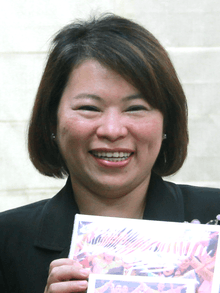
Chiayi City is a provincial city of Taiwan Province of the Republic of China. The city is governed by the Chiayi City Government, while the residence is represented in the Chiayi City Council. The current Mayor of Chiayi City is Huang Min-hui of the Kuomintang.
Administrative divisions
Chiayi City is divided into two districts. East District is the city seat which houses the Chiayi City Government.
| Map | Name | Chinese | Taiwanese | Hakka | Population (2016) | Area (km²) | |
|---|---|---|---|---|---|---|---|
 |
East | 東區 | Tang | Tûng | 122,877 | 29.1195 | |
| West | 西區 | Se | Sî | 147,396 | 30.9061 | ||
Politics
Chiayi City voted one Democratic Progressive Party legislator to be in the Legislative Yuan during the 2016 Taiwanese general election.[9]
Demographics
Chiayi city is a 100% purely ethnic Hokkien inhabited city.
| Year | Pop. | ±% |
|---|---|---|
| 1985 | 253,573 | — |
| 1990 | 257,597 | +1.6% |
| 1995 | 261,391 | +1.5% |
| 2000 | 266,183 | +1.8% |
| 2005 | 272,364 | +2.3% |
| 2010 | 272,390 | +0.0% |
| 2015 | 270,366 | −0.7% |
| Source:"Populations by city and country in Taiwan". Ministry of the Interior Population Census. | ||
Education
- National Chiayi University
- Tatung Institute of Commerce and Technology
- Chung Jen College of Nursing, Health Science and Management
Energy
Green energy
On 17 December 2015, Chiayi City Government launched a program to set up solar panels at schools and offices in the city to reduce green house gases. The program is expected to produce 3.55 million kWh of electricity annually and to help reducing carbon emission by 1,700 tonnes.[10]
Tourist attractions
.jpg)
.jpg)
- Art Site of Chiayi Railway Warehouse
- Chia-Le-Fu Night Market
- Chiayi Botanical Garden
- Chiayi Cheng Huang Temple
- Chiayi City Municipal Baseball Stadium
- Chiayi Cultural and Creative Industries Park
- Chiayi Jen Wu Temple
- Chiayi Municipal Museum
- Chiayi Park
- Chiayi Prison Museum
- Hinoki Village
- Lantan Lake
- Museum of Ancient Taiwan Tiles
- St. John's Cathedral
- Taiwan Hinoki Museum
- Water Source Water Meter Room
- Wenhua Road Night Market
- Historic Archives Building of Chiayi City (史蹟資料館)
- 228 Memorial Park
- National 228 Memorial Park
- Chung Cheng Park[11]
- Alishan Forest Railway & Railway Park
- Chiayi International Band Festival
Chiayi is the city of wind music in Taiwan. The wind music festival started as a local event in 1988, when it was more like a joint performance by local wind music bands. Over the years the festival has become the most anticipated annual event in Chiayi.[12]
Notable residents/natives
- Tan Ting-pho (1895-1947), Taiwan famous painter.
- Sow-Hsin Chen (1935), American physicist, Professor.
- Vincent Siew (1939), Taiwanese politician, Vice President of the Republic of China (2008 – 2012), Vice-Chairman of the Kuomintang.
- Deng Feng-Zhou (1949), Taiwanese poet, Local history writer, Nedan academics.
- Huang Min-hui (1959), former mayor of Chiayi City, vice chairperson of Kuomintang, a member of the Legislative Yuan (1999 and 2005).
- Lo Chen-Jung (1961), Taiwanese left-handed baseball pitcher.
- Wu Bai (1968), Taiwanese rock singer.
International relations
Twin towns — sister cities
Chiayi is twinned with:








Transportation
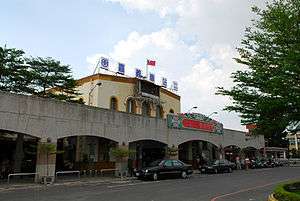
Rail
Chiayi City is accessible from Chiayi Station and Jiabei Station of the Taiwan Railways Administration or a slightly further THSR Chiayi Station in Chiayi County. It also houses the first station for the Alishan Forest Railway.
Bus
The Chiayi Bus Rapid Transit serves Chiayi City with the neighboring Chiayi County, and Chiayi City Bus serves the urban areas of Chiayi City.
Air
Chiayi City is served by Chiayi Airport located in the neighboring Chiayi County.
In Popular Culture
- Chiayi City and its street foods were featured on the Netflix TV series, Street Food (TV series) in season 1.[13]
See also
- List of mayors of Chiayi
- Chiayi County
References
- 《中華民國統計資訊網》縣市重要統計指標查詢系統網 (in Chinese). Archived from the original on 12 June 2016. Retrieved 1 July 2016.
- 嘉義市105年6月份人口統計資料. 嘉義市政府 (in Chinese). Archived from the original on 16 September 2016. Retrieved 1 July 2016.
- Campbell, William (1903). "Explanatory Notes". Formosa under the Dutch: described from contemporary records, with explanatory notes and a bibliography of the island. London: Kegan Paul. p. 549. OCLC 644323041.CS1 maint: ref=harv (link)
- William Campbell (1915). "Sketches from Formosa". pp. 79–81.
It was on a later occasion I arrived in Ka-gi to find the people engaged in their absurd periodic custom of stonethrowing.
- Takekoshi, Yosaburō (1907). "Chapter XIII: Population and future development of the island resources". Japanese rule in Formosa. London, New York, Bombay and Calcutta: Longmans, Green, and co. p. 200. OCLC 753129. OL 6986981M.CS1 maint: ref=harv (link)
- William Campbell (1915). "Sketches from Formosa". pp. 82–83.
- "Archived copy". Archived from the original on 2017-03-14. Retrieved 2016-01-06.CS1 maint: archived copy as title (link)
- "Statistics > Monthly Mean". Central Weather Bureau. Archived from the original on 2009-07-07. Retrieved 2009-06-07.
- "2016 The 14th Presidential and Vice Presidential Election and The 9th Legislator Election". vote2016.cec.gov.tw. Archived from the original on 2016-05-07. Retrieved 2016-01-17.
- "Chiayi City launches solar power system program - Society - FOCUS TAIWAN - CNA ENGLISH NEWS". Archived from the original on 2015-12-18. Retrieved 2015-12-18.
- "Archived copy". Archived from the original on 2015-06-10. Retrieved 2013-11-16.CS1 maint: archived copy as title (link)
- "The sound of wind music: 2008 Chiayi City International Band Festival"by Eva Tang, 17 January 2009, Taiwan Culture Portal. "Archived copy". Archived from the original on 2009-02-03. Retrieved 2009-02-06.CS1 maint: archived copy as title (link)
- Brown, Joshua Samuel. "Taiwan Culture and Cuisine Shine on New Netflix Series "Street Food"". Medium. Commonwealth Magazine. Retrieved 26 July 2020.
External links
- Chiayi City/County tourism official website
- Chiayi City government official website (in Chinese)
- Chiayi City Police Bureau official website


- National Chung Cheng University official website
